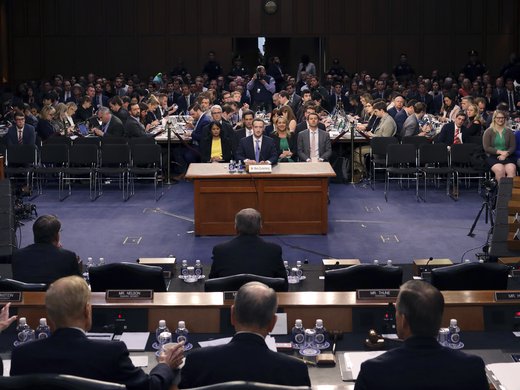“The Internet: An Unprecedented and Unparalleled Platform for Innovation and Change.” That was the title of a chapter published by the World Intellectual Property Organization in 2012. It echoes a commonly expressed sentiment. Back in 2012, most proclamations about the internet praised its unprecedented power. Just five years later, most proclamations about the internet criticized its unprecedented power. Commentators, analysts and policy makers worried that the internet, and social media platforms in particular, presented wholly new threats to democracy, global governance and the integrity of information.
There is a lot to question in the underlying assumption that the internet is unprecedented and unparalleled. That assumption makes it seem as if history is no longer a useful tool of analysis to guide future policies. But history is ubiquitous in our discussions around the internet and disinformation. While some discuss history by claiming that our current circumstances are unprecedented, assumptions about the history of disinformation are everywhere in policy making.
Policy makers in some countries deploy history quite often to guide their regulatory approaches. German policy makers refer frequently to the Nazi and Stasi pasts to justify their actions. Finnish policy makers invested early in media literacy because of long experiences with Russian and Soviet disinformation. Finally, it’s a historical judgment to claim that something is unprecedented; often that turns out not to be true!
As a trained historian, I have spent much of the past decade studying earlier communications technologies, such as radio and telegraphy. And I’ve spent time briefing policy makers in multiple countries about different approaches to our present problems, including what we can learn from the past. It’s given me ample opportunity to consider the uses and abuses of history in addressing contemporary disinformation. And many historians engage in this type of work: in fact, there is a network in the United Kingdom, History & Policy, composed of more than 500 historians who offer their expertise to policy makers and journalists on myriad topics.
But there may be particular uses for history in thinking through disinformation, where claims about history often fall either into simplistic analogies with fascism or assertions of total novelty. There is no “right” way to use history, but there can be more productive approaches.
As Sam Haselby has put it, “Think of history as the depth and breadth of human experience, as what actually happened. History makes the world, or a place and people, what it is, or what they are. In contrast, think of the past as those bits and pieces of history that a society selects in order to sanction itself, to affirm its forms of government, its institutions and dominant morals.” Too often, policy makers use “the past” rather than history, even though the historical discipline may have a surprising amount to offer.
A historian will not supply easy answers, and historians will almost inevitably mention how historical knowledge itself can be abused to justify problematic approaches. At the same time, history enables us to open up our imaginations to alternative information ecosystems, to understand path dependency, and to avoid offering simplistic silver-bullet solutions that have not worked in the past.
Analogies
In the aftermath of the 2016 US presidential election, some historians who rose to prominence did so through their use of analogy, in particular by drawing lines between the new administration’s approach and fascism. Timothy Snyder’s On Tyranny suggested 20 lessons from fascism based on Snyder’s historical writing about Central and Eastern Europe. Other, more knee-jerk commentary compared Donald Trump’s use of Twitter to Joseph Goebbels’s claims about the importance of radio for the Nazis.
Obviously, politics played a role in these comparisons. Just after the January 2021 attack on the Capitol, Joe Biden compared Ted Cruz to Joseph Goebbels for spreading lies about election fraud. Democratic Congressman Jim Clyburn said in March 2020 that he compared Republicans’ support of Trump to Nazi Germany to “sound the alarm.”
Yet sometimes, such comparisons obscure more than they reveal. The Nazis actually did not come to power due to their control over the new technology of radio. In fact, they could only exercise influence on its content after coming to power in January 1933. Successive Weimar governments had put radio content ever more under state supervision, hoping to save democracy. But that meant the Nazis could control radio more swiftly than newspapers, once they gained power. That particular history seems quite far from any analogy to Trump and Twitter.
Beyond pointing out when analogies are less accurate, historians can help with analogical reasoning. This, as Peter Gordon has pointed out, is “indispensable to the human sciences.” It is a human trait to analogize. Rather than dismiss the use of analogy entirely, we might better ask when and where it is appropriate. Sometimes, the more helpful analogy is not to Nazism, for example, but to another phenomenon. Ruth Ben-Ghiat’s recent book, Strongmen, examines a range of past authoritarian leaders from Benito Mussolini to Mobutu Sese Seko, showing the common characteristics of these men. Analogical reasoning subtly undergirds the book but it guides Ben-Ghiat toward a typology of strongmen and how they fall from power, rather than to simplistic analogies between one era and the present.
Within the history of disinformation, pointing out parallels can surface the structural factors behind why disinformation emerges. In the decades before World War I, political elites in Germany came to believe that the British were boxing them in by controlling submarine cable networks and by refusing Germany landing rights in Britain for a transatlantic cable. Geopolitical rivalry in the 1890s helps to explain why Germany started to invest in communications technologies and would continue to do so for the next 50 years. Those technologies underpinned world wars of words multiple times. While this is not a one-to-one fit with our contemporary circumstances, such history can explain why disinformation emerges when and where it does.
Some policy analysts have started to turn to history in this fashion to understand the role of China. Rush Doshi, a senior director for China at the National Security Council, has taken this approach. Before joining the administration of Joseph Biden, Doshi co-authored a Brookings report with Kevin McGuiness in March 2021, arguing that “the notion that power politics could be removed from questions over telecommunications was not only optimistic, it was also out of step with the history of telecommunications.” The report suggests multiple lessons for the present, including the importance of standard setting, the problem of complacency and the limits of encryption.
Rather than seeing the last five years as an anomaly, what happens when policy makers see this is a historical problem that is here to stay?
Chronological Perspectives
While analogies can be a powerful tool, another important historical perspective is asking when something began and ended. This is particularly crucial in the realm of disinformation, because it fundamentally changes our understanding of what policy solutions can achieve. Historians of news have pointed out that complaints about faking in news go back to the start of newspapers themselves in the seventeenth century. English playwright Ben Jonson wrote a masque in 1620, News from the New World Discovered in the Moon, satirizing the news-hungry for their gullibility. His play The Staple of News made fun of the news business in the seventeenth century, just as that business itself was first beginning.
That four-century perspective presents faking in news, reader gullibility and sensationalist profit seeking as persistent problems. There is no single solution for any of them, if they have existed ever since newspapers began. The more interesting question, then, is how to mitigate the amplification of poor-quality news or to understand why it may spread more at certain moments than others.
More specific to the modern phenomenon of disinformation is the perspective that information warfare is a feature, not a bug, of the international system. Rather than seeing the last five years as an anomaly, what happens when policy makers see this as a historical problem that is here to stay? Thomas Rid has traced how the United States and Soviet Union engaged in many types of “active measures” throughout the twentieth century. These ranged from funding magazines to spreading rumours as states attempted to manipulate opinions around the world. The tactics in Rid’s tales are deeply familiar to contemporary experts on disinformation. By showing how these tactics have persisted and evolved from the early twentieth century until today, Rid offers an important lesson for those who would blame technology for disinformation. More important than any specific technology was the underlying geopolitical situation as well as the state capacity and desire to invest in the means to manipulate information.
Understanding when disinformation became a mass phenomenon raises the crucial question of causality. Did disinformation cause something or is it more prevalent for other reasons? The work by Rid and others undermines the classic narrative of technology as the main driver of disinformation; other scholars have also used historical examples to show that disinformation in the United States existed long before 2016. Alice Marwick, Rachel Kuo, Shanice Cameron and Moira Weigel developed a critical disinformation studies syllabus with historical case studies ranging from Japanese incarceration to AIDS/HIV to demonstrate the long-standing prevalence of disinformation in different forms within American society.
The four argue that “many of the stories that pundits, journalists, and scholars tell about disinformation begin with the 2016 US presidential election and focus on the role of social media platforms in spreading and generating false content. At their worst, these narratives imply that in the past, everyone shared the same sense of what was true and what was false; that this collective understanding was reinforced by legacy media like newspapers and TV news; and that ‘fake news,’ disinformation, and inauthentic online behavior are responsible for a global far-right shift to populism exemplified by Brexit and the Trump presidency. None of these assumptions hold up to scrutiny.”
A historical perspective makes clear how the internet may have exacerbated, but not caused, problems in our information ecosystem. Seeing the past through clearer eyes can help to avoid what I call a “golden age nostalgia,” a mistaken belief that the information ecosystem worked seamlessly before the internet. Once we understand that it did not, and why, we can ask what approaches are needed to address the broader political, economic and cultural factors that have long fostered the spread of disinformation.
Some of that perspective means asking about path dependencies. As scholars such as Nicole Starosielski, the author of The Undersea Network, have explored, submarine telegraph cables offer a classic example of path dependency in communications. Nineteenth-century cables have cast a long shadow, influencing where the majority of fibre-optic cables are laid, because they tend to follow the same routes. Imperialism and colonial priorities determined to a large extent where cables were laid in the nineteenth century. Later, telephone, and then submarine fibre-optic cables, followed similar routes, in part because they were already shown to be profitable and in part because it was cheaper to lay cables on ocean beds that had proven safe. Only in the last decade or so has Africa, for example, seen the spread of new fibre-optic cables through networks such as SEACOM, which has laid new routes to connect the continent.
That history matters because it explains the geography of our current data infrastructure. As Roxana Vatanparast has put it, forgetting about data infrastructure “obscures its underlying histories and power dynamics, including the territorial politics, ecological extraction, labor, and forms of knowledge that went into constructing its underlying infrastructures.” Path dependencies do not mean path inevitabilities. But they can point out where deeper-seated structural changes are required and where problems did not emerge in the 2010s, but far earlier.
Alternatives
If analogies and chronologies can provide new perspectives on the present, history can also help to uncover alternatives from the past.
As Isabel Hofmeyr has described, Mahatma Gandhi offered one alternative to even basic assumptions about the role of news. Gandhi saw news as fast-paced and thus inherently prone to misrepresentation. While he was living in South Africa from 1893 to 1914, Gandhi founded his own periodical based on a theory of contemplative reading. Gandhi saw slow reading as a way to develop concentration, self-discipline and ethical values. While the world of slow reading might seem divorced from contemporary reality, Gandhi’s ideas suggest that one answer to the problem of disinformation is to change the nature of news itself.
In other cases, history reminds policy makers of paths not taken or taken long ago. One example is the role of the United States government in communications infrastructure. When Alexis de Tocqueville visited the United States in 1831–1832, he noted that “of all the countries in the world, America is the one with both the most associations and the most newspapers.” Tocqueville attributed this to the “extraordinary fragmentation of administrative power” that promoted local newspapers and bolstered American democracy. Tocqueville did not seem to realize that the purportedly fragmented system relied upon the most federal system in the United States — the post.
Created in 1792, the United States Post Office Department — or simply the Post Office — was the only federal agency in the first years of the republic. The Post Office had a civic mandate and the federal government subsidized newspapers’ postage costs to ensure an affordable exchange of information. In 1830, the post circulated about 16 million newspapers annually and this figure increased by more than two million copies every year for the next 15 years. The federal government’s postal subsidies ensured that in 1832, when Tocqueville was visiting the United States, newspapers made up 95 percent of the weight of the post, but just 15 percent of the department’s revenue. As late as the 1870s, more than 70 percent of federal employees worked for the Post Office. Another crucial aspect of the post’s success was that the federal government guaranteed postal secrecy.
The post was high on the international agenda for the United States, even in times of trial. During the civil war, law maker John A. Kasson travelled to Paris to participate in the first major international postal conference in 1863. Kasson’s appearance lent legitimacy to the North on the international stage. It also ensured that the Universal Postal Union (UPU), when it was created in 1874, drew on the American civic ideal of cheap postage to create protocols for international communications, as pre-eminent postal historian Richard John has shown. The United States also willingly accepted international standards, when it made sense. In 1913, the Post Office created a parcel-post system based on the international UPU convention. Six months after it launched, the Post Office became the Amazon of its day, delivering approximately 300 million packages, lowering rates for customers and driving most private companies out of business.
Many things have, of course, changed since the postal era. Companies such as Google use the most granular personal data in history to make billions from targeted advertising. And Nikki Usher has shown how news outlets struggling to make a profit have become ever less willing and able to serve local and diverse communities.
But the history of the post has also inspired alternative visions for the future. Some scholars, Ethan Zuckerman, for example, have called for a return to public provision, a revamped era of libraries and postal networks for the twenty-first century. Others, like Victor Pickard, have drawn on this history to argue that the United States should develop a public media fund. While this may seem utopian, history reminds us that state support for democratic communications was high on the agenda for early US administrations.
Analogies have their limits. But history can help to disentangle the unprecedented from the historical. It can help to point out where phenomena really are new, such as the scale of internet usage.
Toward a Usable History
In April 2016, Christopher Achen and Larry Bartels published a widely discussed book, Democracy for Realists: Why Elections Do Not Produce Responsive Government. It skewered what Achen and Bartels called the “folk theory of democracy.” By that, they meant the idea that voters support candidates who reflect the overall interests and goals of the citizenry. Instead, Achen and Bartels traced how other factors, such as group identities or national economic performance in the last six months before an election, mattered far more. In a paperback edition of their book in 2017, Achen and Bartels noted in an update how the election of Trump confirmed rather than undermined their work, because they had focused on empirical data rather than started with a folk theory.
It is more than time to move away from folk theories of history, whether they are pinned on the idea that the internet is unprecedented or that the only viable comparison is to fascism. There are many more uses of history that scholars are already pursuing and that have direct relevance for policy making. A deeper understanding of that history will not inevitably prevent poor outcomes. But it can be crucial in preventing worse ones.
All this is not to say that every online phenomenon has a pre-internet analogue. Analogies have their limits. But history can help to disentangle the unprecedented from the historical. It can help to point out where phenomena really are new, such as the scale of internet usage. In those cases, historical knowledge can serve a different purpose. For example, as we face unprecedented climate change, historical knowledge serves, as some scholars working on ecology have suggested, “as a guide and not as a template, accepts multiple potential trajectories for ecosystems, emphasizes process over structure, and embraces pragmatic goals for human well-being.”
History is often uncomfortable or challenging, and it rarely offers easy answers to policy questions. But it can expand our imaginations and point out where problems require deeper, more structural interventions. Addressing the problems of disinformation requires an interdisciplinary approach. There is no reason for history not to have a seat at the table.



